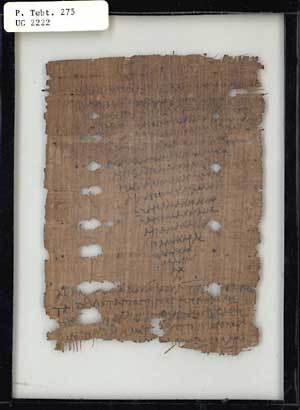|
HOME | SEARCH | ARCHIVE |
|
Rare papyri collection gets new lease on life
New funding will revive
study and digitizing of valuable collection
![]() By
Diane Ainsworth, Public Affairs
By
Diane Ainsworth, Public Affairs
| |
|
04 OCTOBER 00 | More of Berkeley's treasured collection of fragmentary Greek and Egyptian papyri texts will be opened for scholarly examination, cataloguing, digitization and publication on the Internet as a new organized research project gets under way.
The collection, which contains public and private records dating back to 300 B.C. - 300 A.D., is written on papyrus, the ancient equivalent of paper made from strips of papyrus plants from the Nile River. Berkeley's archive is the largest in the United States gathered from a single site, Tebtunis, and is one of only a handful of papyrus collections housed in American universities.
Only 5 percent of the collection - or about 1,100 fragments - has been published or described. Roughly 1,400 fragments are mounted in glass for archival display. Several hundred more fragments have to be removed from plastic mounts, another 22,000 lie untouched in temporary folders, and an unknown number are still sitting in their original tin boxes awaiting attention.
"Although papyri are perhaps best known to the public from discoveries of new poems and ancient writings that had been lost, equally important for scholars are the documents of private and public life that allow historians a first-hand glimpse at the multicultural society of Egypt under the Ptolemaic kings and the Roman empire," said Donald Mastronarde, a classics professor in the College of Letters and Science and chairman of the advisory committee of the new organized research project, called the Center for the Tebtunis Papyri.
"We're on a new course now to bringing a papyrologist on board next year to lead our efforts to study, preserve and publish these unique documents," he said. "We also hope to encourage integrated study of Tebtunis, using the archaeological record, the artifacts and art that are preserved at the Hearst Museum of Anthropology, and the documents in Greek, Demotic (Egyptian) and Latin that are housed here and in other papyri collections in the United States."
Visiting scholars and distinguished papyrologists, including Susan Stephens of Stanford University, who gave an introductory seminar on papyrology recently for new graduate students in classics, believe that most of Berkeley's untouched collection details the social, legal and economic life of Tebtunis, a small, provincial town in southwest Fayum. That region was part of a rich agricultural district of ancient Ptolemaic and Roman Egypt.
"About 30 percent of the uncatalogued and unstudied fragments are thought to be Demotic documents, which is an untapped resource for investigating the Egyptian-speaking and bilingual population living some 2,000 years ago in the multicultural society of Hellenistic and Roman Egypt," Mastronarde said. "The next phase of our work will be to select more of the unstudied fragments, catalogue, digitize and then publish them in a virtual library on the Internet."
Computing resources and the Web make this an ideal time to push forward with academic investigations of the papyrus collection, Mastronarde said. "It is now economically feasible to create digital images of each piece of papyrus and make the images available on the Internet," he said. "Digitization allows these ancient documents to be studied at a distance by papyrologists outside Berkeley, and increases the level of expert collaborative attention that can be brought to bear upon them. A web site can also be used to provide an up-to-date, consolidated and searchable record of previous publications and studies related to the material."
The papyri consist of documents found in the winter of 1899-1900 at the site of ancient Tebtunis, Egypt. For four years, the project of conserving, cataloguing and imaging them has been supported in part by grants from the National Endowment for the Humanities as part of the Advanced Papyrological Information System.
Founding of the new
Center for the Tebtunis Papyri, along with continuing support from the
National Endowment for the Humanities, will continue that work and help
to promote international collaboration and publication of the papyrus
collection.
Home | Search | Archive | About | Contact | More News
Copyright 2000, The Regents of the University of California.
Produced and maintained by the Office of Public Affairs at UC Berkeley.
Comments? E-mail berkeleyan@pa.urel.berkeley.edu.
